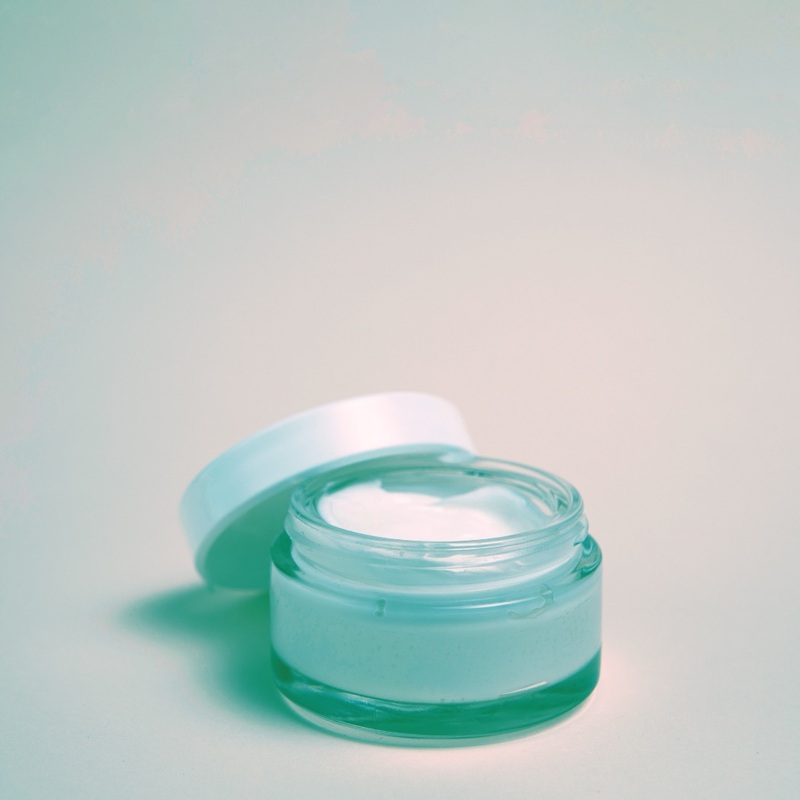There is a lot of information on social media about the use of topical estrogen cream for menopause skin care. Explore this article to find out how changes in hormones at menopause impacts the skin and how to support your skin health.
Menopause and Hormonal Changes
Menopause is the loss of ovarian function that results in reduction in estrogen, progesterone and testosterone production by the ovaries. It can occur naturally at midlife or earlier due to surgical removal of the ovaries or premature menopause (premature ovarian insufficiency).
Estrogen receptors are found in the skin and estrogen play an important role in maintaining skin health and integrity. It helps in the production of collagen, a protein that gives skin its structure and youthful appearance. It also maintains hydration. Loss of estrogen results in thinner, drier and more fragile skin. It also impacts wound healing.
Additionally, relatively lower estrogen to testosterone cause skin issues such as acne, rosacea and increased skin sensitivity. Lower estrogen levels also impact skin dryness.
Related: 13 Things Every Woman Needs To Know About Menopause
34 Symptoms Of Perimenopause and What Can Help
The Menopausal Shift in Hormones and Skin Health
Although some skin changes can be attributed to age (such as 1% collagen loss per year), as estradiol levels drop during perimenopause and menopause, these changes accelerate. For example in the 5 years after menopause 30 percent of collagen is lost from the skin. There are other significant skin changes with menopause including (Lephart, 2021):
-
loss of type I & III collagen,
-
loss of elastin and reduced skin elasticity,
-
loss of fibroblast function,
-
reduced vascularity of the skin,
-
increased matrix metalloproteinases & enzymatic activities, resulting in cellular and extracellular degradation
-
impaired wound healing/barrier function,
-
decreased antioxidant capacity
-
increased transepidermal water loss and decreased skin moisture.
These changes contribute to thin, dry, wrinkled and sagging skin. Luckily, topical estrogen face creams or gels can help replenish the hormone levels in the skin and reduce the effects of low estrogen.
Learn more: Menopause Skincare Glow Guide.
Benefits of Estrogen For Menopausal Skin Changes
Since the 1980s numerous small studies have examined the effects of both topical estradiol and estriol, two types of estrogens that decline with menopause. These studies have examined different parameters of skin health and have found that these estrogens have a number of benefits in the skin.
-
Increased collagen production (Brincat 1987).
-
Thickened elastic fibres in the papillary dermis that are also better oriented and slightly increased in number (Punnonen 1987).
-
Increased epidermal thickness (Punnonen 1987).
-
Reduced signs of skin ageing: vascularization, firmness, elasticity, moisture, wrinkle depth, and pore size (Schmidt 1994)
-
Improved skin hydration: estrogen plays a crucial role in maintaining skin hydration through regulating the levels of ceramides. Estrogen cream increases skin hydration (Piérard-Franchimont 1995)
-
Increased hyaluronic acid (Patriarca 1995).
Systemic Menopause Hormone Therapy And Skin Health
Systemic menopause hormone therapy with transdermal estradiol patches has been shown to have a number of improvements in the skin including:
- increased epidermal skin moisture,
- increased elasticity and
- increased skin thickness
Among for women who used combined systemic HRT (ie estradiol patch and natural progesterone capsules), there was also an increase in skin surface lipids/fatty acids (The influence of hormone replacement therapy on skin ageing 2001).
More research into hormones and skin health is needed to determine long-term benefits of hormones for skin care.
Menopause hormone therapy is a prescription medicine and comes with benefits and risks and should be discussed with your individual health provider.
Topical Estrogen Cream
Topical estrogen preparations contain either estradiol (E2) or estriol (E3) as active ingredients. These are the two types of estrogens that have been studied extensively for their effects on skin health. The concentrations typically studies includes doese between 0.01-0.06% estradiol and 0.3% estriol.
Estrogen is a prescription medicine, it is important to consult with a healthcare professional.
It is also important to follow the instructions provided by the product label and your healthcare provider.
Typically, topical estrogen face cream is applied to the face and neck once daily to clean dry skin.
It is always recommended to use sunscreen and avoid exposure to direct sunlight when using any form of estrogen hormone therapy. This is because estrogen can increase the risk of sun sensitivity, hyperpigmentation and melasma, which is can also occur during pregnancy and with use of the oral contraceptive pill.
Sunscreen is also an essential part of menopausal skin care to reduce photo damage from sun rays.
Side effects of Topical Estrogen Therapy
The dose of estrogen in face cream is low as is systemic absorption, so side effects are uncommon.
However if you experience :
-
skin irritation,
-
skin pigment changes,
-
nausea/vomiting,
-
bloating,
-
breast tenderness,
-
headache, or
-
weight changes,
-
or any other symptoms you suspect could be related to the use of estrogen, you should tell your doctor promptly and get their advice.
Melasma and Estrogen
There is a case report of a woman developing melasma when using a combined estradiol and estriol facial cream twice daily (Melasma Associated with Topical Estrogen Cream). Melasma and pigment changes also occur when women use oral contraceptives containing estrogens.
Melasma is skin hyperpigmentation in blotchy patches. Melasma has multiple causes including;
-
Family history
-
Sun exposure: both ultraviolet & visible light promotes melanin production
-
Hormones: any situation that involves hormones can contribute to melasma including pregnancy, oestrogen/progestin-containing oral contraceptives, intrauterine devices, implants, and hormone replacement therapy, and thyroid disorders.
-
Medications and fragrances: some newer cancer therapies, perfumed soaps, toiletries, and cosmetics can cause a reaction in conjuncton with sun exposure to trigger melasma.
Prevention of melasma when using any form of HRT is best achieved, with year-round, life-long sun protection that includes a broad-brimmed hat, sunscreen containing zinc iron oxides (SPF50+). Also mineral foundation that contains zinc and iron oxides can provide additonal photo-protection.
Sunscreen should be applied twicex per day or more regular in the hot sun/high UV or if swimming. Also seek shade in the hottest parts of the day.
If you do develop melasma discuss with your healthcare provider.
Alternatives to Menopause Hormone Therapy
If you are unable to use menopause hormone therapy for any reason, there are other options available. These include:
-
Phytoestrogens: These are plant-based compounds that mimic the effects of estrogen in the body. Some studies have shown that phytoestrogens such as genistein 4% (Silva 2017) or 0.015% isoflavones (Bayerl 2002) can help improve skin elasticity, collagen production, and moisture levels.
-
Hyaluronic acid: This natural substance helps to maintain skin hydration and can be found in topical skincare products.
-
Retinoids: These Vitamin A derivatives have been shown to improve skin texture and reduce wrinkles. However, they may cause irritation in some individuals, especially at pharmaceutical doses. Also these should be used an night and you should use adequate sunscreen as it increases photosensitivity.
-
Antioxidants: Topical antioxidants include: Vitamin C and E, Co-enzyme Q10, green tea, and resveratrol. These antioxidants help to protect the skin from damage caused by free radicals. These can help protect the skin from oxidative damage and support overall skin health.
By incorporating these ingredients into your menopause skin care routine, along with using estrogen face cream, you can help mitigate the effects of hormonal changes on your skin and promote a healthy, radiant complexion.
Additional Menopausal Skin Care Tips
Estrogen is not the only beneficial support for healthy skin for menopausal women. It is important to consider diet, hydration and avoiding toxicity and damage to your skin.
1. Food to Promote Health Skin
Eating a healthy, balanced diet rich in antioxidants such as:
-
Carotenoids found in Carrots, Orange/yellow/red bell peppers, kumara/sweet potato, Apricots,
-
Leafy greens such as kale, spinach and swiss chard contain many antioxidants including : vitamins C and E, beta-carotene, lutein and zeaxanthin
-
Vitamin E rich foods: Almonds, sunflower seeds, spinach, avocados
-
Vitamin C rich foods: Oranges, strawberries, kiwifruit
-
Omega-3 fatty acid rich foods: oily fish such as salmon, mackerel and sardines as well as vegan sources such as flaxseeds, chia seeds, walnuts and edamame (soy beans).
Related: The Best Anti-Inflammatory Diet for Menopause
2. Hydration for Healthy Skin
-
Staying hydrated by drinking plenty of water.
-
Green Tea contains antioxidants and polyphenols to promote skin health, so it is a useful drink to include for skin care.
3. Avoid Skin Damage
Skin damage occurs when your skin is exposed to environmental factors, that accelerates damage by free radicals . In order to protect your skin, you should:
-
Always wear sunscreen with sun protective factor (SPF) 50 or higher and containing iron oxide - especially if you are using an estrogen facial cream, or any other form of hormone replacement therapy.
-
Avoid tanning beds and excess sun exposure, especially when the UV is at it's highest.
-
Quit smoking: Smoking damages the collagen and elastin in your skin, leading to premature skin aging.
-
Minimise alcohol intake as it impairs the antioxidants in your skin and accelerates skin aging.
-
Avoid chemical irritants such as skincare products that you react to. Use Skin Deep's cosmetic database to check your products.
4. Manage Stress Levels
-
Stress can also affect your skin health by increasing inflammation in the body. Finding ways to reduce stress such as exercise, meditation, or therapy can help improve overall skin health.
-
Also ensuring you get sufficient rest each night so your body and skin has time to rest and repair is essential for healthy skin.
-
Ensuring the lights are dim in the evening so you have adequate melatonin production is important as melatonin is a powerful antioxidant for the skin and also supports sleep.
By incorporating these tips and ingredients into your menopause skin care routine, along with using estrogen face cream, you can help mitigate the effects of hormonal changes on your skin and promote a healthy, radiant complexion.
Estrogen For Skin Health: The Takeaways
-
Estrogen levels decline during menopause, lead to changes in the skin such as dryness, thinning, reduced collagen, reduced elasticity, reduced thickness and reduced hydration.
-
Systemic estrogen or topical estrogen cream can be a helpful tool in managing these changes and promoting healthy skin.
-
Consult your health provider for the best menopause hormone therapy options for you which will take into consideration all your menopausal symptoms and medical history.
-
Skincare is important to maintain healthy structure and function of your skin and shoiuld always include SPF with UV exposure. You may also like to add phytoestrogens, antioxidants, hyaluronic acid, and retinoids.
-
Make sure you include diverse plant foods in your diet, avoid AGEs, get adequate hydration, rest & recovery and manage your stress for healthy skin too!
Dr Deborah Brunt is a menopause doctor at Rebelle Health and would love to support you through the perimenopause and menopausal stages, supporting all aspects of your health and wellbeing.
Join our Menothrive Programs to feel great and love your life during peri and menopause.
Dr Deborah Brunt | Rebelle Health | Book Appointment
**Menopause Hormone Therapy should be prescribed by trained medical professionals. Ask your doctor about the benefits and risks of using MHT and whether it is right for you. If you have any side effects or concerns, speak to your health professional. MHT has benefits and risks. Always follow your doctor’s instructions. For more information refer to the Consumer Medicine Information for estradiol/estriol/progesterone at www.medsafe.govt.nz


